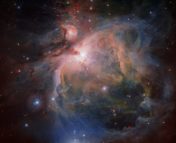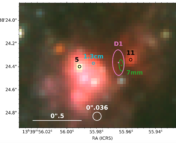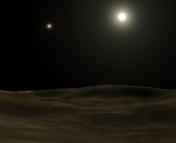Authors: A. T. Barnes, S. N. Longmore, et al.
First Author’s Institute: Astrophysics Research Institute, Liverpool John Moores University, 146 Brownlow Hill, Liverpool L3 5RF, UK
Infrared image of the Rosette molecular cloud. The bright smudges are dusty cocoons containing massive protostars. The small spots near the centre of the image are lower mass protostars. Source: ESA.
What are Young Massive Clusters?
Young massive clusters (YMCs) are the most compact, high-mass stellar systems still forming today. They have masses of above 10,000 times the mass of the sun, ages less than 100 million years and radii less than 1pc (3.25 lightyears). The clouds from which they form from are rare due to their large initial gas reservoirs and rapid dispersal timescales due to stellar feedback. We can observe them however, and thanks to them being at lower redshift, we can resolve individual star formation and test the theories of star and cluster formation. Their lower redshift simply means they’re closer. We also observe YMCs (or at least we think they are!) at higher redshifts but they’re not resolved and so we can’t study them in detail.
Formation theories
We know that the starting point of YMC formation is simply a large cloud of gas and dust, known as molecular clouds. The authors in today’s paper try to answer the question of how a molecular cloud could form a typical YMC, with particular emphasis on the observed densities of these objects. They introduce three different theoretical models, each of which can be distinguished by the densities of the different evolutionary stages, from molecular cloud to YMC. The 3 main current theories are described as:
1) “Conveyor-belt” – where the density of the initial cloud is less than the density of the YMC. In other words, during its evolution the system becomes more dense. Stars form within the cloud from the cold gas within it and as the system evolves, both the gas and the stellar population globally collapse. The remaining gas either cools and forms more stars or is expelled from the cloud completely, until the whole system is dominated by stars, resulting in a smooth, centrally concentrated, bound stellar cluster.
2) “In situ” – where the density of the initial cloud is approximately the same as the density of the resulting YMC. Star formation does not occur straight away, and instead the gas contracts to a certain density at which it starts forming stars. The gas remains at this density, as do the stars formed, and thus this is the observed final YMC stellar density.
3) “Popping” – where the density of the initial cloud is greater than the density of the final YMC. The molecular cloud of gas collapses down before forming any stars, as in the “in-situ” scenario, but this time to an even higher density. Star formation begins at this high gas density but exhausts and expels its gas reservoir quickly, removing the gravitational influence of the gas. The stellar cluster therefore expands slightly towards a final lower stellar density.
Discriminating between these models is clearly complicated, but by obtaining observations at various stages of this evolution from molecular cloud to YMC, we can begin to constrain the theory. The intermediate stage between molecular clouds to stellar clusters are named as ‘proto-clusters’.
So, how do they form?
For their observations, the authors use the Atacama Large Millimetre array (ALMA) of two cloud systems. These clouds are massive, with gas masses of around 100,000 solar masses and they are also compact, with radii of around 1pc (3.26 lightyears). They appear to be globally gravitationally bound and are thought to harbour only the very earliest stage of star formation, making them perfect candidates for YMC progenitor clouds.
ALMA observations are used with high angular resolution (1’’/0.05pc) of two molecular clouds in the Galactic Centre. By using identified molecular line transitions, one can reliably trace the gas structure in the highest density gas. The authors then investigate the mass and density distribution, along with the clouds’ dynamical state. They conduct analysis of the identified core and proto-cluster regions, and show that half of the cores and both of the proto-clusters are unstable to gravitational collapse. This is the first kinematic evidence of global gravitational collapse in YMC precursor clouds at such an early evolutionary stage.
The results imply that if these collapsing clouds were to form YMCs, then they do so via the “conveyor-belt” mode, where stars continually form within dispersed dense gas cores as the cloud globally collapses. This result is also supported by the fact that to the fact that star formation has only recently begun. The authors find all YMC progenitors have a common formation mechanism, regardless of environment, which is surprising considering that the central parts of the galaxy where these YMCs form has extreme environmental conditions.
Young massive clusters are exceptional systems, fiercely still forming stars today, making them the perfect laboratory for furthering our understanding of star formation and stellar cluster formation. This paper helps to constrain one more piece of the puzzle, by establishing the mechanism by which these massive dense systems form. YMCs have been described in other works as the analogues to early universe globular clusters. Therefore, further observations and analysis of these nearby objects may also help us to make suggestions about how stars formed much earlier in our Universe’s history.




